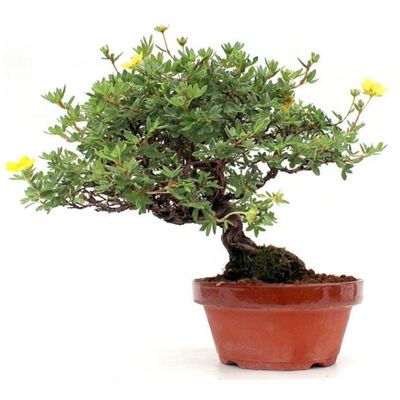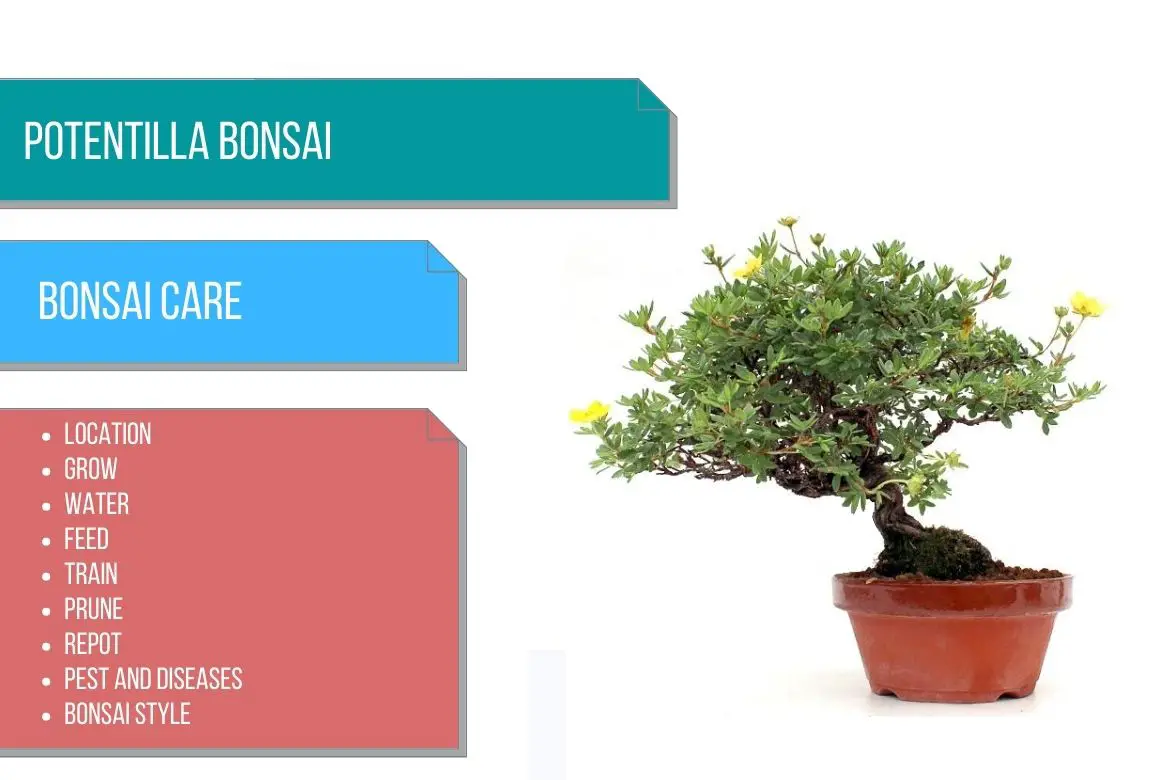
Potentilla / Cinquefoil
(Potentilla Fruticosa)
Country of Origin : North America, Europe, North Asia
Bonsai Styles : Informal upright, slanting, semi-cascade, cascade, broom, clump
Zone : 2 – 7
Potentilla fruticosa (Dasiphora fruticosa) also known as shrubby cinquefoil, golden hardhack, or bush cinquefoil, is a hardy deciduous flowering shrub.
This small shrub has grayish green leaves which are divided into 5 lobes.
The trunk of the plant is dark brown that has a bark that flakes off. Even at a young age, the plant’s bark has an old-looking appearance. This adds a lot of character to the Potentilla bonsai.
The plant also produces long-lasting, buttercup-like, showy, bright yellow flowers throughout the summer. The flowers are produced from the current season’s shoots.
Because of its small leaves, attractive shaggy old-looking bark and flowers, Potentilla bonsai is highly suitable for making a beautiful flowering bonsai tree. In fact, they are very popular in Japan. A fine bonsai specimen can be made with either a thick or a slender trunk. It is suitable for most of the bonsai styles. A Potentilla bonsai can be shaped into a variety of sizes, from extra-small to large bonsai. However, this plant is particularly used as a mame bonsai.
A few other Potentilla fruticosa varieties with different colored flowers can also be used to make a bonsai:
- Potentilla fruticosa ‘Abbottswood’ – Blue green foliage and large white flowers
- Potentilla fruticosa ‘Coronation Triumph’ – Abundant, bright yellow flowers
- Potentilla fruticosa ‘Daydawn’ – Light pink flowers
- Potentilla fruticosa ‘Fargo’ – Deep golden flowers
- Potentilla fruticosa ‘Gold Drop’ – Yellow flowers on a dwarf shrub
- Potentilla fruticosa ‘Goldfinger’ – Dark green foliage, large yellow flowers
- Potentilla fruticosa ‘McKay’s White’ – Creamy white flowers
- Potentilla fruticosa ‘Pink Beauty’ – Pink flowers on a dwarf shrub
- Potentilla fruticosa ‘Red Ace’ – Bright vermilion-red flowers with pale yellow undersides
Read more about other bonsai trees species in : Types of bonsai tree
Best location to keep Potentilla bonsai tree
Potentilla bonsai trees make a stunning outdoor bonsai tree. Keep it in full sun throughout the growing season.
When grown in full sun, the plant will have the most vigorous blooms, although some shade can be beneficial in hot climates.
Even though it prefers bright places, it must be protected from prolonged exposure to strong direct sunlight during the summer.
These trees are hardy in temperate areas and require no special protection in the winter.
IMP: Refer to do bonsai trees need sunlight for more indoor and outdoor bonsai location ideas. Also, refer sunlight requirements for indoor plants for more indoor gardening ideas.
Propagation of Potentilla bonsai tree
You can propagate the plant by taking softwood cuttings in the summer and sowing seeds in the fall.
Watering Potentilla bonsai tree
These trees are fairly tolerant to drought. However, when grown in a pot, water the bonsai regularly during the growing season. Water the tree whenever the soil feels a bit dry to the touch.
However, it is critical not to allow the soil to completely dry out.
In winter, keep the soil just moist.
Read watering bonsai tree for more details and also about bonsai water immersion technique.
Wiring Potentilla bonsai tree
These trees don’t require much wiring. Most of the shaping of Potentilla bonsai is done by pruning.
However, if you still decide to wire train this bonsai, wire hardened shoots in late summer.
Read : Detailed guide on How to wire a bonsai. This extensive guide includes all the wiring techniques and Do’s and Dont’s. It will also show you other bonsai training techniques which can be achieved without using wires.
Pruning Potentilla bonsai tree
When to prune Potentilla bonsai tree?
How to prune Potentilla bonsai tree?
It may be necessary to prune potentilla bonsai frequently due to their vigorous nature.
To keep the foliage compact, new shoots must be continually pruned back.
After flowering, shorten the new shoots in autumn. It is possible to remove unwanted branches at any time.
Also after flowering, remove faded flowers and dried branches.
Pinch the growing tips of secondary shoots when 2-3 new leaves have emerged. This will stimulate the growth of new flowering shoots.
It is important to note that potentilla do not callus over pruning wounds. This characteristic can be used to your advantage when styling your bonsai. If you are pruning large branches, you might want to leave a stub. This can be used to create Jins.
It is one of the few deciduous trees that are suitable for deadwood styles.
Read how to prune a bonsai to know about the right technique of pruning and more about defoliating a bonsai tree.
Repotting Potentilla bonsai tree
When to repot Potentilla bonsai tree?
Repot the tree every second year in early spring, before the buds open.
Also, prune the roots at the time of repotting.
As long as the soil is well drained, the shrubby cinquefoil will adapt to a variety of soil types, including clay.
Use a basic, free-draining bonsai soil mix.
You can also use sharp sand, loam, and peat moss (or garden compost) in the ratio of 2:1:1.
Please check out how to repot a bonsai to know everything about repotting and root pruning a bonsai.
Must Read: Bonsai Soil Recipes
Must read : Choosing the right bonsai container
Feeding Potentilla bonsai tree
From spring to late summer, apply a general feed once every 20-30 days.
Read more about bonsai fertilizer and its application. This will also give you more details on how to feed flowering bonsai trees.
Diseases and pest of Potentilla bonsai tree
Potentilla bonsai trees are relatively trouble free.
Our comprehensive guide: How to identify and treat bonsai pests and diseases is a great resource for you to see all the organic and inorganic remedies you can use.

